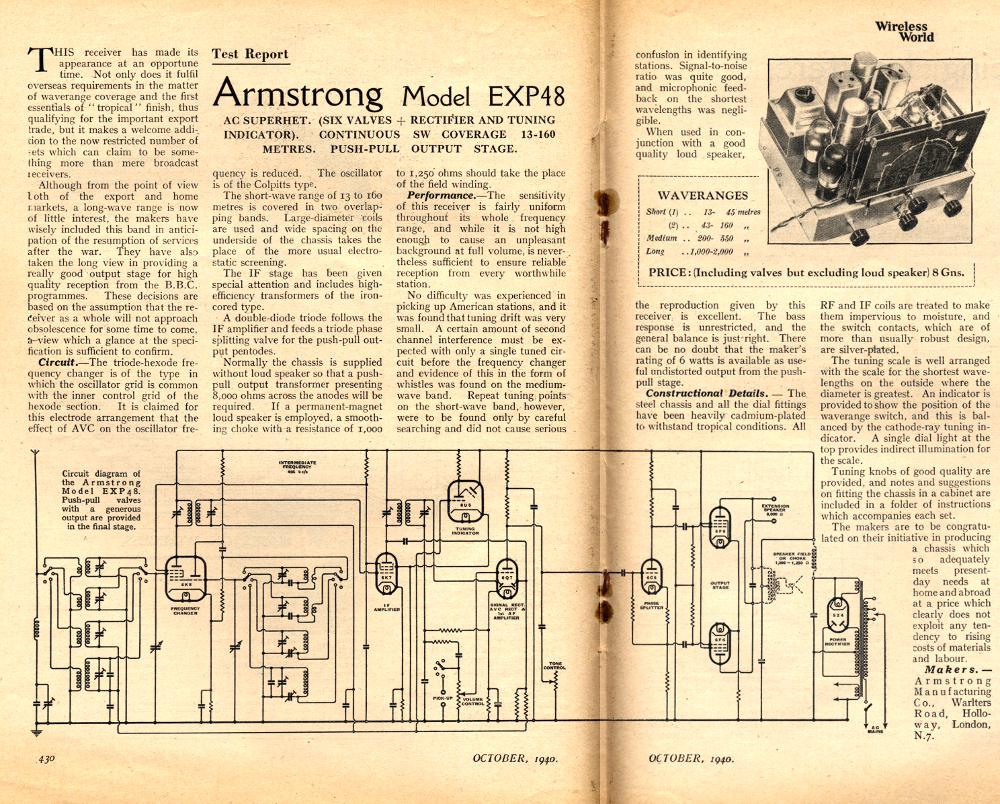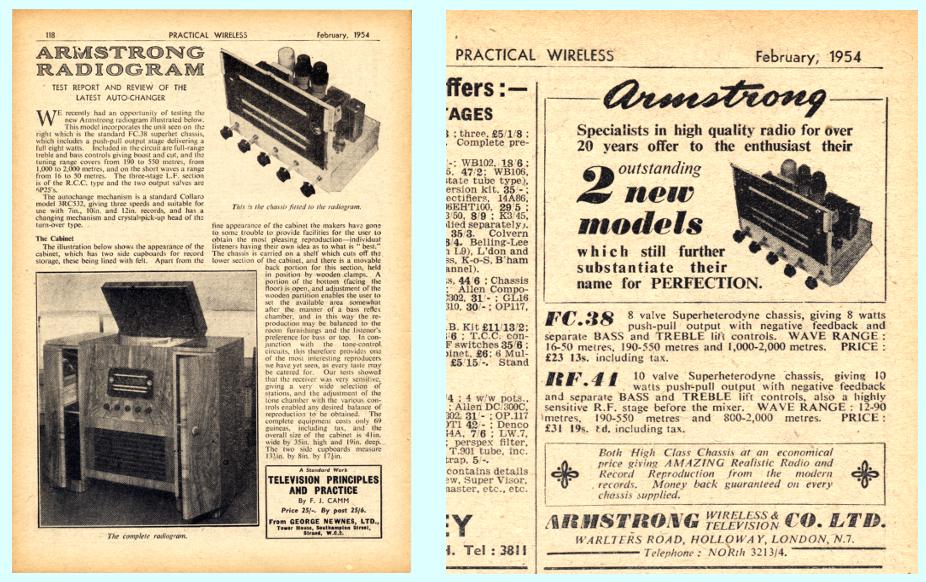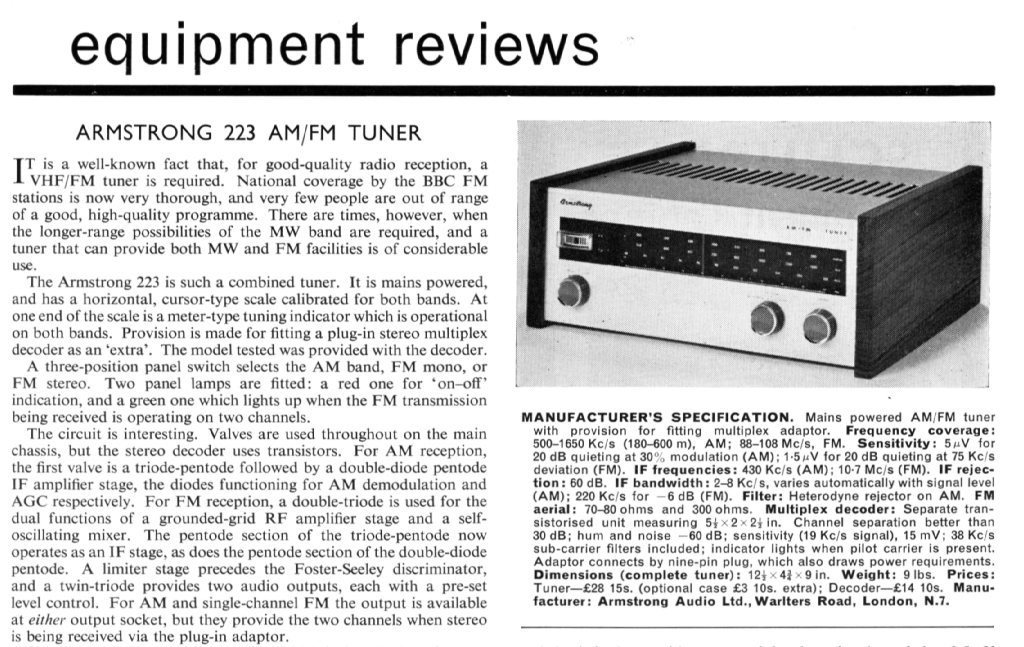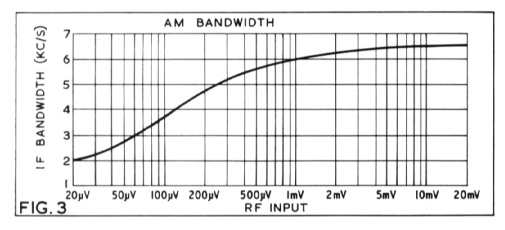
Reviews and Recollections: The Valve Era...
Armstrong produced a very large number of designs over the years. Many were supplied on an OEM basis and given a different brand name. These were bought by shipping lines, hotel chains, etc and give no sign who made them.
Here I will just list a few examples of reviews dealing with items which Armstrong made and sold under their own name. I have included some quotes, scans, and in some cases added my own comments, opinions, and recollections. Note that all the magazines referred to below were United Kingdom publications unless otherwise specified.
AW125PP Radiogram Chassis
1939 January “Wireless World”

Armstrong were founded in 1932. However this is the earliest review of an Armstrong product that I have been able to find so far. It appeared in the January 5th 1939 issue of Wireless World magazine. The AW125PP was an “All Wave” chassis. The tuner covered 5 bands ranging from 12·5 metres to 2000 metres. (Back then it was the norm to specify the wavelength rather than the carrier frequency.) So in modern terms the coverage was from about 150 kHz up to 24 MHz – i.e. the modern Long/Medium/Short waves.
The review gave the manufacturer’s details as:
Armstrong Manufacturing Company, 100, St Pancras Way, Camden Town, N.W.1
The review began by saying:
“In compiling the specification of this receiver the makers have drawn upon the salient features of both long-range communication sets and quality amplifiers for local station reception. By judicious selection and rejection of " frills " the circuit has materialised in a chassis which can be produced with British valves and components throughout at an attractive price without sacrificing anything on the score of efficiency in the first essentials of performance. The makers are justified, too, in showing pride in the mechanical construction of this set. Every detail of the assembly and wiring is neat and workmanlike, the controls are smooth and well graded. The grey enamelled base and natural finished aluminium cans give just the right degree of neatness in appearance without un necessary showmanship.”...
It then gave a detailed discussion of the circuitry and positive comments about performance before ending with:
“Most people who buy a chassis of this type do so with the intention of installing it in an existing cabinet or in a new one of special design. They will undoubtedly be attracted to this receiver by its compactness, which allows much more scope for originality than chassis of conventional proportions. They need have no fear that any sacrifice in performance will follow their choice, particularly if the first consideration is a really lively performance on all wavelengths.”
Back in the days before anyone had heard of the term “high fidelity” units like the AW125PP were regarded as superior-quality “radiogram chassis” models. The buyers were people seeking higher performance than that provided by mass-market radios and radiograms. The assumption was that the buyer would have the skill and enthusiasm to combine the AW125PP with a cabinet, speaker, and gramophone of their preference which they felt would give them the best results.
EXP48 Radiogram Chassis
Wireless World October 1940

The appearance of the EXP48 in 1940 is perhaps something of a surprise when we look back at the period. The United Kingdom had been at war for about a year, and from other accounts the availability of electronic equipment for civilian uses was being hampered by the war effort. However it looks like that – regardless of this – there was a “life goes on” spirit!
The review gave the basic specifications for the EXP48:
Armstrong Model EXP48
AC Superhet (Six valves + rectifier and tuning indicator)
Continuous SW coverage 13 - 160 Metres
Push-Pull output stage
Waveranges: Short (1) 13 - 45 Metres, Short (2) 43 - 160 Metres,
Medium 200 - 550 Metres, Long 1,000 - 2,000 Metres
Price (Including valves but excluding speaker) 8 Guineas
It then made some general comments:
“This receiver has made its appearance at an opportune time. Not only does it fulfil overseas requirements in the matter of waverange coverage and the first essentials of "tropical" finish, thus qualifying for the important export trade, but it makes a welcome addition to the now restricted number of sets which can claim to be something more than mere broadcast receivers.
Although from the point of view both of the export and home markets, a long-wave range is now of little interest, the makers have wisely included this band in anticipation of the resumption of services after the war. They have also taken the long view in providing a really good output stage for high quality reception from the B.B.C. programmes. These decisions are based on the assumption that the receiver as a whole will not approach obsolescence for some time to come. a view which a glance at the specification is sufficient to confirm.”
It then went on to describe the circuit:
“The triode-hexode frequency changer is of the type in which the oscillator grid is common with the inner control grid of the hexode section. ...
Large-diameter coils are used and wide spacing on the underside of the chassis takes the place of the more usual electrostatic screening. The IF stage has been given special attention and includes high- efficiency transformers of the iron- cored type. A double-diode triode follows the IF amplifier and feeds a triode phase splitting valve for the push-pull output pentodes.”
before explaining that:
“Normally the chassis is supplied without loud speaker so that a push- pull output transformer presenting 8,000 ohms across the anodes will be required. If a permanent-magnet loud speaker is employed, a smoothing choke with a resistance of 1,000 to 1,250 ohms should take the place of the field winding.”
Today, it is usual for audio amplifiers to be designed to directly drive loudspeakers with typical impedances around 4 to 16 Ohms. And the established ’dynamic’ design for loudspeakers uses a strong permanent magnet to enable them to operate. But 75 years ago loudspeaker designs were rather more varied. Some loudspeakers used an electromagnetic coil to produce the required fixed magnetic field. This coil then had to be ‘energised’ by passing a steady current though it before the loudspeaker could work.
Because of this it was common for amplifiers and sets to provide a direct current output for such a loudspeaker ‘field coil’. This being so, many manufacturers made double use of the coil and also employed it as a smoothing coil/resistor for the high tension (high voltage) supply provided to power the rest of the amplifier or radio set. The impedances of the available loudspeakers also varied a lot more than today.
None of this mattered if someone went out and bought a complete radio or radiogram in a cabinet as a finished item. They would come ready-to-use as a single boxed unit with their own loudspeaker, etc, included. But the EXP48 was a ‘chassis’ model aimed at discerning users whose approach paralleled those today who collect and combine their own separate units to build a hi-fi ‘system’. Hence it was left to the user to choose the loudspeaker, and any matching transformer they judged would deliver the best results. In effect, the EXP48 is an example of the focus Armstrong had from the 1930s onward on the ‘enthusiast’ market. Buyers who wanted quality and were willing to assemble and combine items to get better sound. What we might these days call the “hi-fi separates market”.
The review went on to say:
“No difficulty was experienced in picking up American stations, and it was found that tuning drift was very small. ...
When used in conjunction with a good quality loudspeaker, the reproduction given by this receiver is excellent. The bass response is unrestricted, and the general balance is just right. There can be no doubt that the maker's rating of 6 watts is available as useful undistorted output from the push- pull stage.”
In our ‘internet age’ it may be worth saying that back in 1940 the BBC’s taste in entertainment tended to be rather staid and starchy. If you wanted to hear something like the latest jazz you needed to try and pick up broadcasts from elsewhere. So being able to ‘pull in’ such remote stations and obtain good sound from them was important.
The review concluded with:
“The makers are to be congratulated on their initiative in producing a chassis which so adequately meets present-day needs at home and abroad at a price which clearly does not exploit any tendency to rising costs of materials and labour.”
What isn’t clear now, however, is how many EXP48’s were actually made during the war. As this continued a number of adverts appeared in Wireless World and other magazines which made clear that components for building and repairing domestic radios were in very short supply. Armstrong’s factory was also engaged in building items for munitions.
FC38 Radiogram chassis
Practical Wireless February 1954

In addition to making and selling ‘chassis’ radios and radiograms Armstrong also occasionally arranged with other makers to sell complete radiograms. The FC38 reviewed by Practical Wireless in February 1954 is an example. The review dealt with the complete radiogram based on an FC38. Above also shows an advert in the same issue that Armstrong placed for those who might prefer to buy the FC38 chassis.
The review made the following comments:
“This model incorporates the unit seen on the right which is the standard FC.38 superhet chassis, which includes a push-pull output stage delivering a full eight watts. Included in the circuit are full-range treble and bass controls giving boost and cut, and the tuning range covers from 190 to 550 metres, from 1,000 to 2,000 metres, and on the short waves a range from 16 to 50 metres. The three-stage L.F. section is of the R.C.C. type and the two output valves are 6P25's.
The autochange mechanism is a standard Collaro model 3RC532, giving three speeds and suitable for use with 7in., l0in. and 12in. records, and has a changing mechanism and crystal pick-up head of the turn-over type.”
It concluded by saying:
“A portion of the bottom (facing the floor) is open, and adjustment of the wooden partition enables the user to set the available area somewhat after the manner of a bass reflex chamber, and in this way the reproduction may be balanced to the room furnishings and the listener's preference for bass or top. In conjunction with the tone-control circuits, this therefore provides one of the most interesting reproducers we have yet seen, as every taste may be catered for. Our tests showed that the receiver was very sensitive, giving a very wide selection of stations, and the adjustment of the tone chamber with the various controls enabled any desired balance of reproduction to be obtained.
The complete equipment costs only 69 guineas, including tax, and the overall size of the cabinet is 41in. wide by 35in. high and 19in. deep. The two side cupboards measure 13.5in. by 8in. by 17.5in.”
FM61 FM tuner
1957 September “Hi Fi News” rev. by R. S. Roberts
 The review discussed the circuitry of the FM61 and identified some imperfections. For example, he commented:
The review discussed the circuitry of the FM61 and identified some imperfections. For example, he commented:
“The scale calibration was checked and found to be reasonably accurate from 88 to 98 Mc/s, but an increasing error developed over the remainder of the scale, being 1 Mc/s out at 108 Mc/s.”
But he also pointed out that:
“The European F.M. channels occupy only 88-100 Mc/s and thus only about half the tuning scale will be used in this country.”
So despite finding some imperfections, overall he concluded that:
“The FM 61 is a good example of a medium-priced tuner which is capable of producing a good programme over a wide range of input signal levels.”
ST3 AM/FM tuner
1961 June “Hi Fi News” rev. by Arthur W. Wayne
 The review started with:
The review started with:
“The most noticeable characteristic of the Armstrong ST3 Mark 2 Tuner is its restrained good taste. This is not to say that its performance is not up to modern standards, but it does what it does with such an absence of flourish and fuss, and in so unobtrusive manner, that “good breeding ” seems to be the most apposite description of its behaviour; and well-bred it should be, for Armstrong’s reputation as manufacturers of good amplifiers and tuners goes back to the misty past of ancient hi-fi history. There is no doubt about the good taste of the front panel, either, as this, although as clear to read as any we have seen, is positively aristocratic in appearance and material. The styling is such as to permit unobtrusive commingling with literally any furnishing decor, from avant-garde to early Jacobean.”
The reviewer complimented Armstrong on various aspects of the measured performance and sound. But did raise two specific concerns on the example of the ST3 which was provided.
Having outlined the circuitry and test results he concluded with:
“To sum up. The Armstrong ST3 mark 2 is one of the most acceptable tuners, for both styling and performance, to have passed through our hands. It is carefully and strongly constructed (as one would expect from Armstrong), and its performance is entirely adequate for all normal usages. Quality of reproduction is unusually fine, while stability on FM is of a very high order indeed. The music-lover with first-class equipment can do no better than buy this instrument to complete an outstanding hi-fi system.”
PCU25 Preamp/Control Unit + A20 Valve Power Amp:
1962 April “Gramophone” rev. by Philip G. Tandy
 The review introduces the PCU25 + A20 to Gramophone readers with:
The review introduces the PCU25 + A20 to Gramophone readers with:
“This is an entirely new stereo amplifier and pre-amplifier by Armstrong Ltd.”
It goes on to describe the appearance, etc, and adds:
“Each main amplifier consists of a high gain triode stage, coupled to a double triode phase splitter, followed by two EL84’s in pushpull, using the familiar ultra linear circuit.”
The reviewer explains that the PCU25 has two tape inputs, inputs for crystal and magnetic stereo pickups (i.e. cartridges for record replay), etc. It also provides switches to allow different separate mono sources to be selected from either Left or Right inputs, or to be played in parallel! Also:
“The treble control works in conjunction with the treble filter so that the turnover point is progressively lowered as treble cut is introduced. With treble at level, the filter produces a slope of 12 dB per octave starting at 9 kc/s. Treble at 11 o’clock produces a slope of 9 dB per octave starting at 7kc/s. Treble at 10 o’clock gives a slope of 5 dB per octave starting at 5 kc/s. This system provide in effect a variable frequency filter giving a-wide range of control.”...
“It is to be expected that an amplifier that performs so well on test will prove excellent under listening conditions and this is no exception. Listening tests were therefore conducted primarily with a view to finding out the effect of the treble filter control when worn and noisy LPs were being played. The degree of control was entirely suitable for these rather difficult conditions for it was possible to remove a large amount of unwanted noise whilst still retaining a good musical balance.”
1962 April “Hi Fi News” rev. by George W. Tillett

George Tillett’s review started with:
“The Armstrong PCU25 and A20 combination has quite an impressive specification (and performance!), and so is a worthy addition to the Armstrong range which now comprises a selection of Hi-Fi equipment to suit almost every taste---and pocket. The main unit, the A20, is fairly conventional in design and consists of two power amplifiers on one chassis; but the control unit has one or two rather unusual features.”
The review then outlined the details of the circuity and tests performed. In some ways finding better results than the earlier “Gramophone” review, before concluding:
“The workmanship is of a high order and in the control unit the components are mounted on a Paxolin sheet with conventional wiring--in other words a compromise between ordinary assembly and a printed circuit. The components themselves are of good quality and the units should give very little trouble. Summing up then, I would put this Armstrong combination in the highest class and subject to the reservations noted recommend it to the most discriminating.”
1962 May “Amateur Tape Recording” – rev. by Fred Judd

“These Amplifiers have been reviewed together because the PCU25 unit is a twin channel multi-input pre-amplifier designed to operate with the A20 twin channel power amplifier. Together they form a complete amplifier system for high quality tape, radio or gramophone record reproduction. The PCU25 pre-amplifier has inputs suitable for direct connection to tape heads, low sensitivity magnetic pick-ups, radio tuners and microphone, and can also be used as a tape recording amplifier. (It does not include a bias oscillator).”
and he went on to make detailed measurements on aspects like the low distortion performance of the A20 stereo power amplifier. This review was one which Armstrong later reproduced in full in advertising literature for the PCU25 / A20 combination.
1962 September “Audio and Record Review”

This review largely covered the same ground as earlier ones on the PCU25 and A20. It concluded that:
“The PCU25/A20 combination is in the best Armstrong tradition of quality with more than usual value for money. If one has to make a comparison its performance and features are not as good as equipment costing twice as much, but this is hardly a criticism! .Our listening tests - with Warfedale “Slimlines” and Mordaunt “Arundel” speakers - confirmed our impressions from the measurements. With a pair of these Wharfedale speakers, it is possible to assemble a stereo system for less than £100, and that remember with 12 watts of output in each channel. Follow the detailed instructions manual supplied and any enthusiast would have a high fidelity system which he can be justly proud to demonstrate to his friends.”
200 Range
1964 July “Hi Fi News” 222 Amplifier rev. by George W. Tillett

George Tillett’s review of the 222 began by saying:
“The importance of good styling cannot be over-emphasised, and as far as audio equipment is concerned a tuner or amplifier must look good as well as having a good specification from the engineering point of view. Unfortunately, few engineers have an aptitude or, rather, flair for external design (sometimes termed 'cosmetics') and many beautifully engineered products are spoilt by dull, unimaginative presentation.
However, one of the audio firms who have had the sense to call in specialised industrial designers is Armstrong, and a few months ago all their range of amplifiers and tuners were re-styled by Wright & Connor Ltd. The Model 222 under review is an integrated stereo amplifier in chassis form with a simple perspex panel, but it is obvious that much thought has been given to the choice of a colour scheme, knobs, and even the selection of a suitable type face.”
After the technical examination he concluded that:
“The 222 is obviously not intended for the top hi-fi market and so no provision is made for magnetic pickups. However, extremely good results can be obtained with modern lightweight ceramic pickups such as the Decca Deram and the new Sonotone 9TA, both of which were used for test purposes. Many people limited by financial considerations cannot afford to buy a high quality transcription turntable, and here the rumble-filter will enable a fairly cheap player to be used without dire effects!”
These comments probably illuminate what Armstrong had in mind when designing the 222!
The 200 range represented a significant step in the evolution of Armstrong products. It had begun life in the 1930’s making valve radios and radiogram “chassis”. It establishing itself as a provider of high quality examples at prices enthusiasts could afford. During the 1940’s and 1950’s “High Fidelity” had slowly started to grow in Britain. But until around 1960 it had remained of interest only to a small minority who were usually technically literate with practical skills. They tended to want to make their own choices right down to matters like the choice of cabinet or casework.
During the 1960’s a new and growing market emerged. Buyers who wanted good sound but simply wanted to buy a decently packaged set of units as consumer goods they could easily connect together and enjoy. This – along with the imminent arrival of transistors – was to change the market. Alongside the established PCU25 and A20 aimed at the more technical and demanding customers, Armstrong created the 200 range to suit this new market demand. One sign of this was the increasing focus on styling, careful ergonomic design, etc. Another was the growing assumption that buyers would want cased units rather than bare chassis. In line with this the A20 and PCU25 were given a restyling and continued to be sold as the 220 Power Amplifier and 225 Pre-amplifier units representing the “top of the range” amplifiers.
1965 October “Hi Fi News” 223 AM/FM Tuner rev. by R. S. Roberts

“It is a well-known feature of MW reception that good quality cannot be obtained due to the need for high selectivity, and the consequent loss of the higher modulating frequencies. An ideal AM tuner would operate with a high degree of selectivity for the weak distant station, but would have an increased band-width when tuned to the strong local station. This tuner claims to incorporate 'automatic' selectivity control, and this was investigated. The circuit does not show any obvious system for varying the band-width as the signal level changes. Tests were made, however, and fig. 3 shows how the selectivity does, in fact, change (band-width to -3 dB points). It is presumed that the operation of AGC voltage changes the input capacitance of the controlled stages and thereby the tuning of the associated circuits. Whatever the reason, it is a worth- while effect.”

The 223 had been designed by Ted Rule, and I asked him about this some years later. He told me that he’d found this behaviour by accident and incorporated it as being very useful! In practice as the AM signal level rose the impedances of the amplification stages altered, changing the loading on the filters, adjusting the response in this beneficial way.
1966 March “Hi Fi News” 221 Amplifier rev. by L. N. Hully

From the model number, ‘221’, it would be easy to assume that this amplifier appeared before the ‘222’ – or at least at the same time. But in reality the 221 was designed and released some time after the 222. The reason was given at the start of Len Hulley’s review:
“The Armstrong 221 is a logical development from the 222 previously reviewed in this magazine (July 1965). The advent and variety of low-priced magnetic cartridges has resulted in a need for reasonably priced good quality amplifiers with magnetic input facilities. It was with considerable interest that the reviewer received the 221, as it is a hybrid circuit employing both valves and transistors. ”
Having examined the 221 he concluded:
“Even before considering the additional feature of magnetic input facilities, this amplifier represents good value for money and should appeal particularly to readers envisaging the construction of stereo systems on a restricted budget.”
It had become clear once the 222 was on sale that there was a demand for a similar unit that provided for the ‘magnetic’ cartridges. Hence the 221 was essentially a 222 to which a suitable preamp had been added. In terms of the history of Armstrong product developments the 221 is significant because it was their first model that employed transistors.
2800 Words
Jim Lesurf
14th Sep 2015
expanded 12th Apr 2016